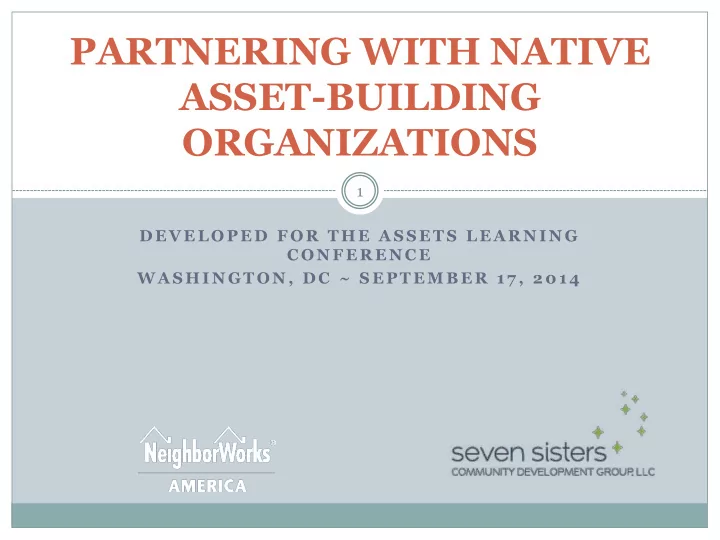

PARTNERING WITH NATIVE ASSET-BUILDING ORGANIZATIONS 1 D E V E L O P E D F O R T H E A S S E T S L E A R N I N G C O N F E R E N C E W A S H I N G T O N , D C ~ S E P T E M B E R 1 7 , 2 0 1 4
Thank You 2 Special thanks to the Native CDFI Network for supporting this workshop to benefit CFED partner organizations’ work with Native Nations Partnering with Native Asset-Building Organizations
Welcome 3 Partnering with Native Asset-Building Organizations
Course Objective 4 Support participants’ efforts to develop effective partnerships with Native asset-building organizations. Partnering with Native Asset-Building Organizations
Agenda Overview 5 Welcome & Introductions Snapshot of Indian Country Examining culture Historical overview Sovereignty & federal trust responsibility Today’s landscape Setting the stage for partnerships Next steps Partnering with Native Asset-Building Organizations
Introduction Activity 6 Partnering with Native Asset-Building Organizations
Snapshot of Indian Country 7 • Native American, American Indian, First Nations, Indian, Native, and Indigenous. • 2.4 million Native people in the U.S. • 566 distinct federally recognized tribal nations(culturally and linguistically distinct) (1/2 in Alaska) • 245 state recognized tribes Partnering with Native Asset-Building Organizations
Examining Culture 8 Partnering with Native Asset-Building Organizations
Culture Includes 9 Customary beliefs, social norms, and material traits of a racial, religious, or social group. Characteristic features of everyday existence (as diversions or a way of life) shared by people in a place or time. Set of shared attitudes, values, goals, or practices that characterizes an institution or organization. Partnering with Native Asset-Building Organizations
Understanding Cultural Paradigms 10 Finite versus infinite resources Partnering with Native Asset-Building Organizations
Understanding Cultural Paradigms 11 Interdependence versus individualism Partnering with Native Asset-Building Organizations
Understanding Cultural Paradigms 12 Extended family versus immediate family Partnering with Native Asset-Building Organizations
Understanding Cultural Paradigms 13 Direct versus indirect communication Partnering with Native Asset-Building Organizations
Historical Overview of Native American History 14 TO UNDERSTAND INDIAN COUNTRY TODAY, WE MUST LOOK AT HISTORY... Partnering with Native Asset-Building Organizations
Historical Map 15 Partnering with Native Asset-Building Organizations
Key Periods in Native American History 16 Pre-1492 Pre-Columbian Period 1942 – 1828 Colonial Period 1828 – 1887 Removal, Reservation and Treaty Period 1887 – 1934 Allotment and Assimilation Period 1934 – 1945 Indian Reorganization Period 1945 – 1968 Termination Period 1968 – Present Self-Determination Period Partnering with Native Asset-Building Organizations
Sovereignty and the Federal Trust Relationship 17 PRESIDENT GEORGE BUSH’S CONCEPT OF SOVEREIGNTY Partnering with Native Asset-Building Organizations
Sovereignty and American History 18 Why did the United States want to be an independent, sovereign country? Partnering with Native Asset-Building Organizations
19 Sophie Pierre , Chief Commissioner of the NATIVE British Columbia Treaty Commission, former Chief of the St. Mary’s Indian Band and former SOVEREIGNTY administrator of the Ktunaxa/Kinbasket Tribal Council; Ktunaxa Nation Wilma Mankiller (deceased), Former WHAT CONCEPTS DID Principal Chief of the Cherokee Nation of YOU HEAR? Oklahoma Jamie Fullmer, Former Chairman; Yavapai- Apache Nation Suzan Harjo, Poet, writer, lecturer, curator http://nnidatabase.org/ and policy advocate ; Cheyenne and Hodulgee db/video/rebuilding- Muscogee native-nations-course- John "Rocky" Barrett, Chairman; Citizen series-defining- Potawatomi Nation sovereignty. Floyd Jourdain , Chairman, Red Lake Band of Chippewa Patricia Ninham-Hoeft , Secretary of the Business Committee, Oneida Tribe of Indians of Wisconsin Partnering with Native Asset-Building Organizations
Federal Trust Responsibility 20 The federal Indian trust responsibility is a legal obligation under which the United States “has charged itself with moral obligations of the highest responsibility and trust” toward Indian tribes. The federal government promised to protect and provide health care, education, housing economic development, agricultural assistance for lands they took from tribes. Partnering with Native Asset-Building Organizations
Today’s Landscape: Opportunities and Challenges 21 • Self Determination • Cultural Revitalization • Language Revitalization • Tribal Sovereignty o Education o Economic development o Land use o Health o Child welfare Partnering with Native Asset-Building Organizations
Creating Successful Partnerships in Indian Country 22 Partnering with Native Asset-Building Organizations
Learn About the Community 23 Conduct Research Learn protocols and etiquette Introductions Elders Handshakes Eye contact Meetings Pace of conversation Disagreeing Partnering with Native Asset-Building Organizations
Build and Maintain Relationships 24 Be aware of the community’s historical experience Focus on listening, respect, and being authentic Go to the community Practice patience Nurture relationships over time Try to identify a community navigator or liaison Partnering with Native Asset-Building Organizations
Develop a Mutually Beneficial Agenda 25 Reflect on key components of successful partnerships Identify mutual benefits of potential or proposed partnership Develop collaborative project goals Establish co-leadership Revisit goals, expectations and process periodically Partnering with Native Asset-Building Organizations
Create Internal Capacity 26 Develop staff cross-cultural capacity Examine program requirements Provide training on unique programs and procedures Identify a potential relationship manager Partnering with Native Asset-Building Organizations
Next Steps…Your Partnership Plan 27 "IF YOU HAVE COME HERE TO HELP ME, YOU ARE WASTING OUR TIME. BUT IF YOU HAVE COME BECAUSE YOUR LIBERATION IS BOUND UP WITH MINE, THEN LET US WORK TOGETHER.” LILLA WATSON Partnering with Native Asset-Building Organizations
Thank you for participating! 28 For more information contact: Lee Anne Adams NeighborWorks America ladams@nw.org Vickie Oldman-John Seven Sisters Community Development Group, LLC kitseallyboy@gmail.com Partnering with Native Asset-Building Organizations
Recommend
More recommend